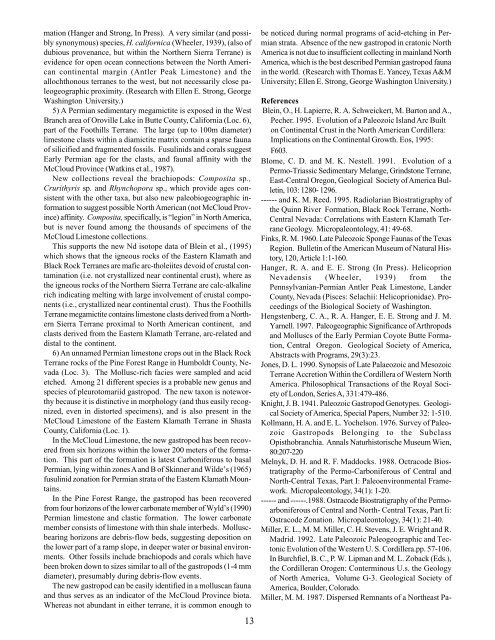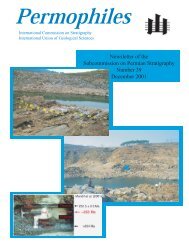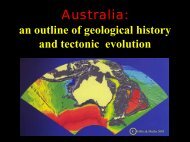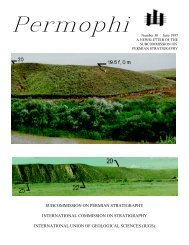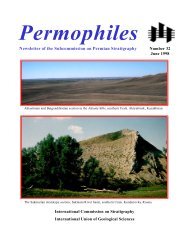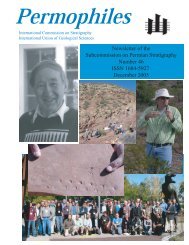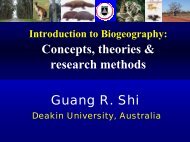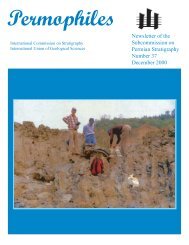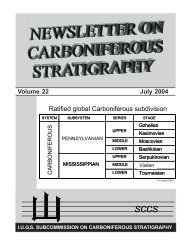Number 31 January 1998 Newsletter of the Subcommission on ...
Number 31 January 1998 Newsletter of the Subcommission on ...
Number 31 January 1998 Newsletter of the Subcommission on ...
You also want an ePaper? Increase the reach of your titles
YUMPU automatically turns print PDFs into web optimized ePapers that Google loves.
mati<strong>on</strong> (Hanger and Str<strong>on</strong>g, In Press). A very similar (and possibly<br />
syn<strong>on</strong>ymous) species, H. californica (Wheeler, 1939), (also <str<strong>on</strong>g>of</str<strong>on</strong>g><br />
dubious provenance, but within <str<strong>on</strong>g>the</str<strong>on</strong>g> Nor<str<strong>on</strong>g>the</str<strong>on</strong>g>rn Sierra Terrane) is<br />
evidence for open ocean c<strong>on</strong>necti<strong>on</strong>s between <str<strong>on</strong>g>the</str<strong>on</strong>g> North American<br />
c<strong>on</strong>tinental margin (Antler Peak Limest<strong>on</strong>e) and <str<strong>on</strong>g>the</str<strong>on</strong>g><br />
allochth<strong>on</strong>ous terranes to <str<strong>on</strong>g>the</str<strong>on</strong>g> west, but not necessarily close paleogeographic<br />
proximity. (Research with Ellen E. Str<strong>on</strong>g, George<br />
Washingt<strong>on</strong> University.)<br />
5) A Permian sedimentary megamictite is exposed in <str<strong>on</strong>g>the</str<strong>on</strong>g> West<br />
Branch area <str<strong>on</strong>g>of</str<strong>on</strong>g> Oroville Lake in Butte County, California (Loc. 6),<br />
part <str<strong>on</strong>g>of</str<strong>on</strong>g> <str<strong>on</strong>g>the</str<strong>on</strong>g> Foothills Terrane. The large (up to 100m diameter)<br />
limest<strong>on</strong>e clasts within a diamictite matrix c<strong>on</strong>tain a sparse fauna<br />
<str<strong>on</strong>g>of</str<strong>on</strong>g> silicified and fragmented fossils. Fusulinids and corals suggest<br />
Early Permian age for <str<strong>on</strong>g>the</str<strong>on</strong>g> clasts, and faunal affinity with <str<strong>on</strong>g>the</str<strong>on</strong>g><br />
McCloud Province (Watkins et al., 1987).<br />
New collecti<strong>on</strong>s reveal <str<strong>on</strong>g>the</str<strong>on</strong>g> brachiopods: Composita sp.,<br />
Crurithyris sp. and Rhynchopora sp., which provide ages c<strong>on</strong>sistent<br />
with <str<strong>on</strong>g>the</str<strong>on</strong>g> o<str<strong>on</strong>g>the</str<strong>on</strong>g>r taxa, but also new paleobiogeographic informati<strong>on</strong><br />
to suggest possible North American (not McCloud Province)<br />
affinity. Composita, specifically, is “legi<strong>on</strong>” in North America,<br />
but is never found am<strong>on</strong>g <str<strong>on</strong>g>the</str<strong>on</strong>g> thousands <str<strong>on</strong>g>of</str<strong>on</strong>g> specimens <str<strong>on</strong>g>of</str<strong>on</strong>g> <str<strong>on</strong>g>the</str<strong>on</strong>g><br />
McCloud Limest<strong>on</strong>e collecti<strong>on</strong>s.<br />
This supports <str<strong>on</strong>g>the</str<strong>on</strong>g> new Nd isotope data <str<strong>on</strong>g>of</str<strong>on</strong>g> Blein et al., (1995)<br />
which shows that <str<strong>on</strong>g>the</str<strong>on</strong>g> igneous rocks <str<strong>on</strong>g>of</str<strong>on</strong>g> <str<strong>on</strong>g>the</str<strong>on</strong>g> Eastern Klamath and<br />
Black Rock Terranes are mafic arc-tholeiites devoid <str<strong>on</strong>g>of</str<strong>on</strong>g> crustal c<strong>on</strong>taminati<strong>on</strong><br />
(i.e. not crystallized near c<strong>on</strong>tinental crust), where as<br />
<str<strong>on</strong>g>the</str<strong>on</strong>g> igneous rocks <str<strong>on</strong>g>of</str<strong>on</strong>g> <str<strong>on</strong>g>the</str<strong>on</strong>g> Nor<str<strong>on</strong>g>the</str<strong>on</strong>g>rn Sierra Terrane are calc-alkaline<br />
rich indicating melting with large involvement <str<strong>on</strong>g>of</str<strong>on</strong>g> crustal comp<strong>on</strong>ents<br />
(i.e., crystallized near c<strong>on</strong>tinental crust). Thus <str<strong>on</strong>g>the</str<strong>on</strong>g> Foothills<br />
Terrane megamictite c<strong>on</strong>tains limest<strong>on</strong>e clasts derived from a Nor<str<strong>on</strong>g>the</str<strong>on</strong>g>rn<br />
Sierra Terrane proximal to North American c<strong>on</strong>tinent, and<br />
clasts derived from <str<strong>on</strong>g>the</str<strong>on</strong>g> Eastern Klamath Terrane, arc-related and<br />
distal to <str<strong>on</strong>g>the</str<strong>on</strong>g> c<strong>on</strong>tinent.<br />
6) An unnamed Permian limest<strong>on</strong>e crops out in <str<strong>on</strong>g>the</str<strong>on</strong>g> Black Rock<br />
Terrane rocks <str<strong>on</strong>g>of</str<strong>on</strong>g> <str<strong>on</strong>g>the</str<strong>on</strong>g> Pine Forest Range in Humboldt County, Nevada<br />
(Loc. 3). The Mollusc-rich facies were sampled and acid<br />
etched. Am<strong>on</strong>g 21 different species is a probable new genus and<br />
species <str<strong>on</strong>g>of</str<strong>on</strong>g> pleurotomariid gastropod. The new tax<strong>on</strong> is noteworthy<br />
because it is distinctive in morphology (and thus easily recognized,<br />
even in distorted specimens), and is also present in <str<strong>on</strong>g>the</str<strong>on</strong>g><br />
McCloud Limest<strong>on</strong>e <str<strong>on</strong>g>of</str<strong>on</strong>g> <str<strong>on</strong>g>the</str<strong>on</strong>g> Eastern Klamath Terrane in Shasta<br />
County, California (Loc. 1).<br />
In <str<strong>on</strong>g>the</str<strong>on</strong>g> McCloud Limest<strong>on</strong>e, <str<strong>on</strong>g>the</str<strong>on</strong>g> new gastropod has been recovered<br />
from six horiz<strong>on</strong>s within <str<strong>on</strong>g>the</str<strong>on</strong>g> lower 200 meters <str<strong>on</strong>g>of</str<strong>on</strong>g> <str<strong>on</strong>g>the</str<strong>on</strong>g> formati<strong>on</strong>.<br />
This part <str<strong>on</strong>g>of</str<strong>on</strong>g> <str<strong>on</strong>g>the</str<strong>on</strong>g> formati<strong>on</strong> is latest Carb<strong>on</strong>iferous to basal<br />
Permian, lying within z<strong>on</strong>es A and B <str<strong>on</strong>g>of</str<strong>on</strong>g> Skinner and Wilde’s (1965)<br />
fusulinid z<strong>on</strong>ati<strong>on</strong> for Permian strata <str<strong>on</strong>g>of</str<strong>on</strong>g> <str<strong>on</strong>g>the</str<strong>on</strong>g> Eastern Klamath Mountains.<br />
In <str<strong>on</strong>g>the</str<strong>on</strong>g> Pine Forest Range, <str<strong>on</strong>g>the</str<strong>on</strong>g> gastropod has been recovered<br />
from four horiz<strong>on</strong>s <str<strong>on</strong>g>of</str<strong>on</strong>g> <str<strong>on</strong>g>the</str<strong>on</strong>g> lower carb<strong>on</strong>ate member <str<strong>on</strong>g>of</str<strong>on</strong>g> Wyld’s (1990)<br />
Permian limest<strong>on</strong>e and clastic formati<strong>on</strong>. The lower carb<strong>on</strong>ate<br />
member c<strong>on</strong>sists <str<strong>on</strong>g>of</str<strong>on</strong>g> limest<strong>on</strong>e with thin shale interbeds. Molluscbearing<br />
horiz<strong>on</strong>s are debris-flow beds, suggesting depositi<strong>on</strong> <strong>on</strong><br />
<str<strong>on</strong>g>the</str<strong>on</strong>g> lower part <str<strong>on</strong>g>of</str<strong>on</strong>g> a ramp slope, in deeper water or basinal envir<strong>on</strong>ments.<br />
O<str<strong>on</strong>g>the</str<strong>on</strong>g>r fossils include brachiopods and corals which have<br />
been broken down to sizes similar to all <str<strong>on</strong>g>of</str<strong>on</strong>g> <str<strong>on</strong>g>the</str<strong>on</strong>g> gastropods (1-4 mm<br />
diameter), presumably during debris-flow events.<br />
The new gastropod can be easily identified in a molluscan fauna<br />
and thus serves as an indicator <str<strong>on</strong>g>of</str<strong>on</strong>g> <str<strong>on</strong>g>the</str<strong>on</strong>g> McCloud Province biota.<br />
Whereas not abundant in ei<str<strong>on</strong>g>the</str<strong>on</strong>g>r terrane, it is comm<strong>on</strong> enough to<br />
13<br />
be noticed during normal programs <str<strong>on</strong>g>of</str<strong>on</strong>g> acid-etching in Permian<br />
strata. Absence <str<strong>on</strong>g>of</str<strong>on</strong>g> <str<strong>on</strong>g>the</str<strong>on</strong>g> new gastropod in crat<strong>on</strong>ic North<br />
America is not due to insufficient collecting in mainland North<br />
America, which is <str<strong>on</strong>g>the</str<strong>on</strong>g> best described Permian gastropod fauna<br />
in <str<strong>on</strong>g>the</str<strong>on</strong>g> world. (Research with Thomas E. Yancey, Texas A&M<br />
University; Ellen E. Str<strong>on</strong>g, George Washingt<strong>on</strong> University.)<br />
References<br />
Blein, O., H. Lapierre, R. A. Schweickert, M. Bart<strong>on</strong> and A.,<br />
Pecher. 1995. Evoluti<strong>on</strong> <str<strong>on</strong>g>of</str<strong>on</strong>g> a Paleozoic Island Arc Built<br />
<strong>on</strong> C<strong>on</strong>tinental Crust in <str<strong>on</strong>g>the</str<strong>on</strong>g> North American Cordillera:<br />
Implicati<strong>on</strong>s <strong>on</strong> <str<strong>on</strong>g>the</str<strong>on</strong>g> C<strong>on</strong>tinental Growth. Eos, 1995:<br />
F603.<br />
Blome, C. D. and M. K. Nestell. 1991. Evoluti<strong>on</strong> <str<strong>on</strong>g>of</str<strong>on</strong>g> a<br />
Permo-Triassic Sedimentary Melange, Grindst<strong>on</strong>e Terrane,<br />
East-Central Oreg<strong>on</strong>, Geological Society <str<strong>on</strong>g>of</str<strong>on</strong>g> America Bulletin,<br />
103: 1280- 1296.<br />
------ and K. M. Reed. 1995. Radiolarian Biostratigraphy <str<strong>on</strong>g>of</str<strong>on</strong>g><br />
<str<strong>on</strong>g>the</str<strong>on</strong>g> Quinn River Formati<strong>on</strong>, Black Rock Terrane, North-<br />
Central Nevada: Correlati<strong>on</strong>s with Eastern Klamath Terrane<br />
Geology. Micropale<strong>on</strong>tology, 41: 49-68.<br />
Finks, R. M. 1960. Late Paleozoic Sp<strong>on</strong>ge Faunas <str<strong>on</strong>g>of</str<strong>on</strong>g> <str<strong>on</strong>g>the</str<strong>on</strong>g> Texas<br />
Regi<strong>on</strong>. Bulletin <str<strong>on</strong>g>of</str<strong>on</strong>g> <str<strong>on</strong>g>the</str<strong>on</strong>g> American Museum <str<strong>on</strong>g>of</str<strong>on</strong>g> Natural History,<br />
120, Article 1:1-160.<br />
Hanger, R. A. and E. E. Str<strong>on</strong>g (In Press). Helicopri<strong>on</strong><br />
Nevadensis (Wheeler, 1939) from <str<strong>on</strong>g>the</str<strong>on</strong>g><br />
Pennsylvanian-Permian Antler Peak Limest<strong>on</strong>e, Lander<br />
County, Nevada (Pisces: Selachii: Helicopri<strong>on</strong>idae). Proceedings<br />
<str<strong>on</strong>g>of</str<strong>on</strong>g> <str<strong>on</strong>g>the</str<strong>on</strong>g> Biological Society <str<strong>on</strong>g>of</str<strong>on</strong>g> Washingt<strong>on</strong>.<br />
Hengstenberg, C. A., R. A. Hanger, E. E. Str<strong>on</strong>g and J. M.<br />
Yarnell. 1997. Paleogeographic Significance <str<strong>on</strong>g>of</str<strong>on</strong>g> Arthropods<br />
and Molluscs <str<strong>on</strong>g>of</str<strong>on</strong>g> <str<strong>on</strong>g>the</str<strong>on</strong>g> Early Permian Coyote Butte Formati<strong>on</strong>,<br />
Central Oreg<strong>on</strong>. Geological Society <str<strong>on</strong>g>of</str<strong>on</strong>g> America,<br />
Abstracts with Programs, 29(3):23.<br />
J<strong>on</strong>es, D. L. 1990. Synopsis <str<strong>on</strong>g>of</str<strong>on</strong>g> Late Palaeozoic and Mesozoic<br />
Terrane Accreti<strong>on</strong> Within <str<strong>on</strong>g>the</str<strong>on</strong>g> Cordillera <str<strong>on</strong>g>of</str<strong>on</strong>g> Western North<br />
America. Philosophical Transacti<strong>on</strong>s <str<strong>on</strong>g>of</str<strong>on</strong>g> <str<strong>on</strong>g>the</str<strong>on</strong>g> Royal Society<br />
<str<strong>on</strong>g>of</str<strong>on</strong>g> L<strong>on</strong>d<strong>on</strong>, Series A, 3<str<strong>on</strong>g>31</str<strong>on</strong>g>:479-486.<br />
Knight, J. B. 1941. Paleozoic Gastropod Genotypes. Geological<br />
Society <str<strong>on</strong>g>of</str<strong>on</strong>g> America, Special Papers, <str<strong>on</strong>g>Number</str<strong>on</strong>g> 32: 1-510.<br />
Kollmann, H. A. and E. L. Yochels<strong>on</strong>. 1976. Survey <str<strong>on</strong>g>of</str<strong>on</strong>g> Paleozoic<br />
Gastropods Bel<strong>on</strong>ging to <str<strong>on</strong>g>the</str<strong>on</strong>g> Subclass<br />
Opisthobranchia. Annals Naturhistorische Museum Wien,<br />
80:207-220<br />
Melnyk, D. H. and R. F. Maddocks. 1988. Octracode Biostratigraphy<br />
<str<strong>on</strong>g>of</str<strong>on</strong>g> <str<strong>on</strong>g>the</str<strong>on</strong>g> Permo-Carb<strong>on</strong>iferous <str<strong>on</strong>g>of</str<strong>on</strong>g> Central and<br />
North-Central Texas, Part I: Paleoenvir<strong>on</strong>mental Framework.<br />
Micropale<strong>on</strong>tology, 34(1): 1-20.<br />
------ and ------.1988. Ostracode Biostratigraphy <str<strong>on</strong>g>of</str<strong>on</strong>g> <str<strong>on</strong>g>the</str<strong>on</strong>g> Permoarb<strong>on</strong>iferous<br />
<str<strong>on</strong>g>of</str<strong>on</strong>g> Central and North- Central Texas, Part Ii:<br />
Ostracode Z<strong>on</strong>ati<strong>on</strong>. Micropale<strong>on</strong>tology, 34(1): 21-40.<br />
Miller, E. L., M. M. Miller, C. H. Stevens, J. E. Wright and R.<br />
Madrid. 1992. Late Paleozoic Paleogeographic and Tect<strong>on</strong>ic<br />
Evoluti<strong>on</strong> <str<strong>on</strong>g>of</str<strong>on</strong>g> <str<strong>on</strong>g>the</str<strong>on</strong>g> Western U. S. Cordillera.pp. 57-106.<br />
In Burchfiel, B. C., P. W. Lipman and M. L. Zoback (Eds.),<br />
<str<strong>on</strong>g>the</str<strong>on</strong>g> Cordilleran Orogen: C<strong>on</strong>terminous U.s. <str<strong>on</strong>g>the</str<strong>on</strong>g> Geology<br />
<str<strong>on</strong>g>of</str<strong>on</strong>g> North America, Volume G-3. Geological Society <str<strong>on</strong>g>of</str<strong>on</strong>g><br />
America, Boulder, Colorado.<br />
Miller, M. M. 1987. Dispersed Remnants <str<strong>on</strong>g>of</str<strong>on</strong>g> a Nor<str<strong>on</strong>g>the</str<strong>on</strong>g>ast Pa-


